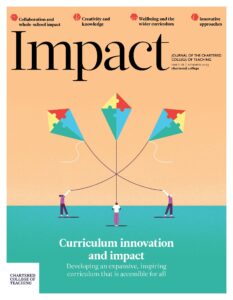Reconsidering oracy: Improving paired discussions in a secondary history classroom

HELEN RIDDLE, DIRECTOR OF TEACHING & LEARNING, ST DUNSTAN’S COLLEGE, UK
Context
Inspired by the Educational Endowment Foundation’s guidance report on improving literacy (Quigley and Coleman, 2021), our recent whole-school CPL (continuous professional learning) has focused on literacy. Staff chose one of three linked CPL sessions that responded to the EEF report: teaching targeted vocabulary (EEF recommendation 2), reading complex texts (recommendation 3) and oracy (recommendation 6). This differentiated for participants’ needs and interests (Cordingley et al., 2015) and followed Kennedy’s (2016) emphasis on combining content knowledge with broader pedagogical goals.
My department’s focus on oracy was something that we had not looked at closely, even though history lessons are often discursive and student talk featured regularly in lessons. Following the EEF’s recommendation of promoting high-quality talk as part of departmental training (Quigley and Coleman, 2021), we aimed to improve the quality of paired discussion in lessons.
The evidence
Alexander (2012) asserts that quality classroom talk has a measurable impact on academic attainment. The benefits of oracy are reflected in robust evidence from over 20 international studies, and include greater retention of subject-specific knowledge and reasoning skills. Millard and Gaunt (2018) emphasise the cognitive gains that can result from a focus on oracy, including improved results in English, maths and science, and ‘transference’ of reasoning skills across subject areas. Davies’s (2020) focus on secondary education is compelling. Although spoken communication requires careful support in Early Years education, Davies argues that this trajectory must continue in all educational stages. Oracy is crucial in continuing the development of skills of reasoning required by secondary school students.
Exploration of research identified several approaches that are important in implementing a revived approach to oracy:
- Build a culture of oracy (Davies, 2020)
- Improve teacher talk by modelling and scaffoldingProgressively introducing students to new concepts to support their learning subject-specific terminology and tier three vocabulary (Didau, 2014; Quigley, 2018; Alexander, 2012)
- Define the purpose of student conversation (Gaunt and Stott, 2019)
- Have a system for turn-taking (Millard and Gaunt, 2018; Quigley and Coleman, 2021)
- Teach listening skills (Gaunt and Stott, 2019).
Crucially, these focus on improving students’ oracy in core curriculum lessons, rather than allowing oracy to be the preserve of drama productions and debating societies. This is important in avoiding accidentally suggesting that oracy and ‘public speaking’ are the same, or that the way in which we form our dialogue only matters in certain circumstances. In many settings, oracy is the focus of ‘opt-in’ activities, which risks leading to the ‘Matthew effect’ of accumulated advantage: those with apparent ‘flair’ for dialogue are encouraged and improve. The shy child, the EAL (English as an additional language) child or the child who does not regularly experience high-quality conversation outside the classroom can be left behind.
Reviving paired discussions
My intervention focused on points 3 (purpose), 4 (turn-taking) and 5 (listening). These followed the EEF’s assertion (Quigley and Coleman, 2021) that ‘quality of talk is likely to be more important than quantity’ (p. 27). A recent lesson observation target suggested that I ‘provide more time and focus for paired discussions, so that these can add to students’ academic development as well as developing interest’. Although previously I had planned teacher exposition and questioning carefully, I rarely devoted time to planning paired interludes, even though they featured in almost all my lessons. At best, my instruction ‘and now discuss that with your partner’ led to academically diluted conversations in which confident students took the lead. At worst, conversations were off-task or stilted. They did not lead mastery of subject terminology or eloquent academic dialogue.
Recommendations for change
Defining the purpose of student conversation
To keep the purpose of paired episodes clear, I started to be more directive. While the focus for discussion varied depending on the topic, it was always possible to find one. In Key Stage 3 lessons on Elizabeth I’s religious settlement, paired discussions had the purpose of: creating a list of Elizabeth’s concerns, establishing two opposing views about the decoration of churches, or reaching consensus (by creating a hypothetical religious settlement).
Often my desired outcome was that students would use tier three vocabulary precisely (in the example above, puritan, liturgy and vestements are good examples). I scaffolded this by providing a short list of relevant key terms on a whiteboard or handout and stating the purpose of using as many as possible in a discussion. This encouraged students to practise using academic language that was unfamiliar to them.
Systems for turn-taking
Again, my previous prompt of ‘and now discuss that with your partner’ was deficient. It was not clear who should speak first, so frequently the more confident student in a pair would dominate, allowing others to opt out. Sometimes my circulation of a room would reveal a quiet student completely ignoring the instruction to have paired discussion, in favour of completing work alone! This denied them the chance to rehearse their answers or develop important skills of reasoning and dialogue. With a little more planning, my instructions created clear roles for each participant.
For example, with a Key Stage 4 class studying Roosevelt’s economic policy: You are working in pairs to contrast views on the New Deal. Person A is a Republican. Once we start, they will speak first. Person B is a Democrat. They will listen and respond: ‘I recognise that. However…’ Spend 30 seconds thinking about what you will say [30 second pause…] Okay – person A, off you go!
Teaching approaches to listening
Paired discussion requires students to listen to each other; Gaunt’s (2018) guidance on full-body listening, cognitive listening and micro-listening was influential. The physical markers of listening (full-body listening) were the easiest to develop and monitor. For instance: Turn to face the speaker, pens down and eyes up. ‘Cognitive listening’ meant that students were prompted to listen to each other to help develop understanding. It was measurable by asking listeners to summarise what the speaker said, to ask a question of clarification or to challenge what a student has said (with a reason). This was encouraged by the turn-taking set out above. ‘Micro listening’ was something that students seemed to adopt with much enthusiasm: listening out for key terms or a particular phrase. Example: Raise your hand when Jack says… or Count how many key terms Nia includes.
The insistence on good listening helped to ensure that episodes in a lesson where one student was speaking remained useful for the whole class. By requiring students to be more cognitively engaged in their listening, it helped to ensure that learning time was maximised for all.
Observations
Qualitative observations (in the context of a ‘Lesson Study’ cycle) revealed that defining the purpose and desired outcome of student conversation and implementing turn-taking frequently led to more focus in paired discussions. Students were less likely to deviate from the intended activity than they had been a few weeks prior. Observation showed that students’ body language changed when turn-taking was introduced: students were more likely to face each other or lean in to listen than they had been previously, and less likely to continue working on their own written work when they should have been talking.
Over the course of a half-term, I explicitly planned paired discussions for all my lessons, following the suggestions set out previously. I noticed that off-task discussion was much less common. The ability to ‘rehearse’ answers in paired discussions appeared to lead to improved spoken answers in hands-down questioning episodes; use of tier three vocabulary and the academic language of reasoning (such as ‘whereas’ and ‘however’ in their appropriate usages) was notably more common than with other classes I had taught previously. Students also scored highly in key terms tests; their definitions of key historical terminology (e.g. Reformation and liturgy) were precise.
This felt like a very low-effort and high-impact intervention. Once I turned my attention to them, the prompts and scaffolds for paired discussion were easy to determine and communicate and required no additional resources, aside from perhaps some prompts on the whiteboard.
This was a small-scale study and it is not clear how long-lasting these benefits might be. Following Millard and Gaunt (2018), we can hope that the emphasis on oracy in lessons, particularly as part of a whole-school focus on academic literacy more broadly, will lead to improved results in the longer term.
This approach to intervention also formed part of my work towards the Teacher Development Trust Associate Qualification in CPL Leadership.
- Alexander R (2012) Improving oracy and classroom talk in English schools: Achievements and challenges. In: Department for Education seminar on Oracy, the National Curriculum and Educational Standards, London, UK, 20 February 2012.
- Cordingley P, Higgins S, Greany T et al. (2015) Developing great teaching: Lessons from the international reviews into effective professional development. Teacher Development Trust. Available at: https://tdtrust.org/wp-content/uploads/2015/10/DGT-Full-report.pdf (accessed 16 March 2023).
- Davies S (2020) Talking About Oracy: Developing Communication Beyond the Classroom. Woodbridge: John Catt.
- Didau D (2014) The Secret of Literacy; Making the Implicit Explicit. Bancyfelin: Independent Thinking Press.
- Gaunt A and Stott A (2019) Transform Teaching and Learning through Talk: The Oracy Imperative. Lanham: Rowman & Littlefield.
- Kennedy M (2016) How does professional development improve teaching? Review of Educational Research. 86(4): 945–980.
- Millard W and Gaunt A (2018) Speaking up: The importance of oracy in teaching and learning. Impact 3: 12–15.
- Quigley A (2018) Closing the Vocabulary Gap. Oxon: Routledge.
- Quigley A and Coleman R (2021) Improving literacy in secondary schools: Guidance report. Educational Endowment Foundation. Available at: https://d2tic4wvo1iusb.cloudfront.net/eef-guidance-reports/literacy-ks3-ks4/EEF_KS3_KS4_LITERACY_GUIDANCE.pdf?v=1635355220 (accessed 9 December 2022).










